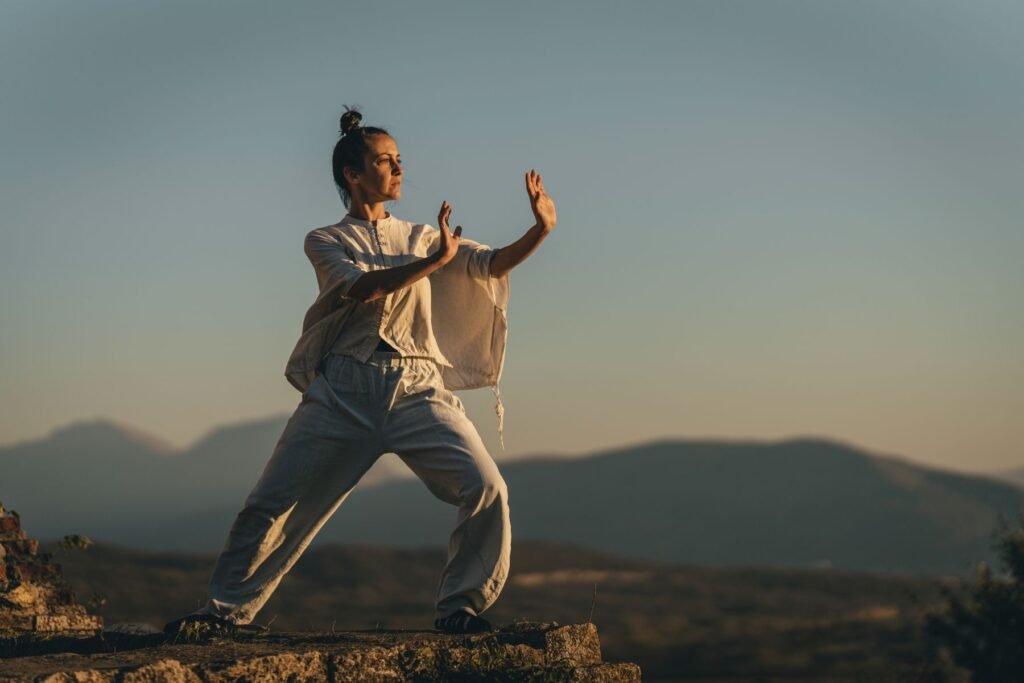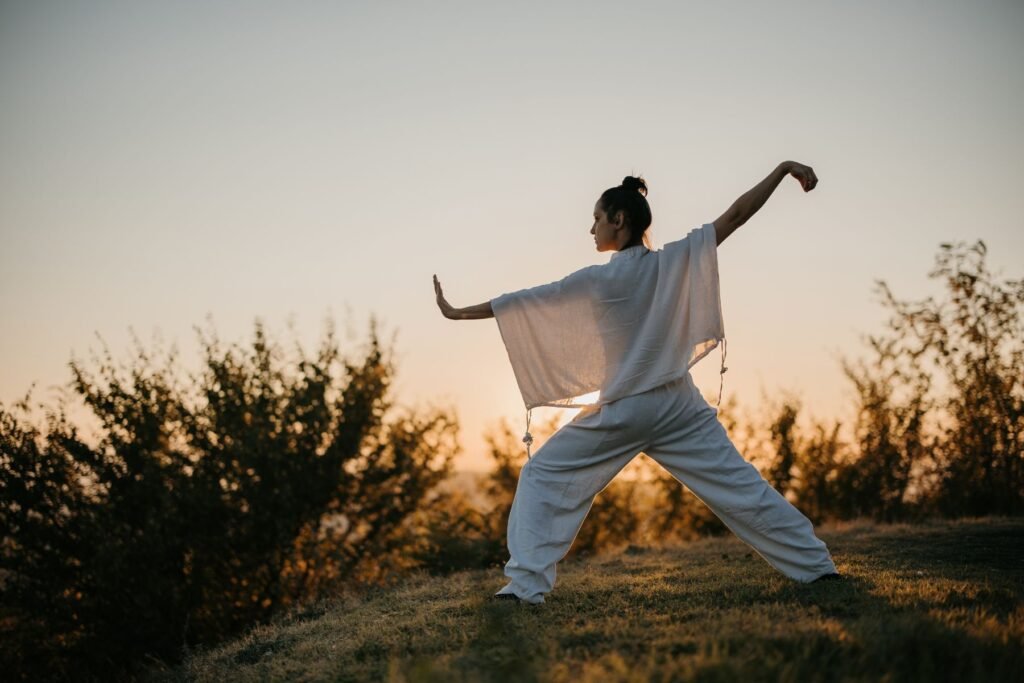QUICK LINKS
GET IN TOUCH
What is Taichi?
Tai Chi (太极 Tàijí), often referred to as Tai Chi Chuan (太极拳 Tàijí quán), is a traditional Chinese martial art renowned for its graceful, flowing movements and deep connection to Chinese philosophy. Rooted in principles of balance, harmony, and the cultivation of internal energy (qi), Tai Chi is practiced worldwide today for its health benefits, meditative qualities, and martial applications. Although originally developed for self-defense, Tai Chi is now most commonly associated with promoting physical and mental well-being.

Historical Background
Tai Chi traces its origins to China during the Ming dynasty (1368–1644), although its exact beginnings are shrouded in legend and debate. One of the most famous origin stories credits Zhang Sanfeng, a Taoist monk, with creating Tai Chi after observing the interplay between a snake and a crane. Historically, Tai Chi evolved within Chinese martial arts families, particularly the Chen family of Chenjiagou Village in Henan province, where the earliest verifiable form of Tai Chi emerged.
Over centuries, Tai Chi was passed down through generations, giving rise to various styles, each with distinct characteristics but sharing core principles. From its martial roots, Tai Chi gradually became associated with health cultivation and spiritual development, aligning with Taoist, Confucian, and Buddhist philosophies.
Major Styles of Tai Chi
Tai Chi encompasses several traditional styles, each with unique features while adhering to common principles of softness, circular movement, and internal power:
Chen Style (陈式 Chénshì)
The oldest Tai Chi style, characterised by alternating slow and explosive movements, low stances, and spiraling energy (silk reeling). It preserves more of the martial applications in its forms.Yang Style (杨式 Yángshì)
The most widely practiced style globally. Yang style features slow, steady, and expansive movements, focusing on relaxation, continuity, and upright posture.Wu (Hao) Style (武式 or 郝式 Wǔshì or Hàoshì)
Known for small, compact movements and an emphasis on internal alignment and precision. Wu (Hao) style is often considered the most subtle of the major styles.Wu Style (吴式 Wúshì)
A style that blends characteristics of Yang and Chen, with compact stances and subtle movements. It is distinguished by forward-leaning postures and internal focus.Sun Style (孙式 Sūnshì)
A modern style that incorporates elements of Tai Chi, Xing Yi, and Bagua. It is noted for agile steps and fluid, open movements that transition smoothly.

Principles and Techniques of Tai Chi
Tai Chi is more than a series of movements — it is a sophisticated system of principles that integrates the body, mind, and breath. These principles guide the practitioner toward internal harmony, external balance, and martial effectiveness. Mastery of Tai Chi arises from patient study and application of these core concepts.
Yin and Yang Balance (阴阳平衡)
Tai Chi is deeply rooted in the Taoist concept of yin and yang — the complementary forces that shape the universe. Every Tai Chi movement expresses the interplay of opposites:
softness and firmness
advance and retreat
rising and sinking
opening and closing
In practice, this means that a practitioner learns to balance these elements in motion. For example, while one part of the body yields (yin), another part simultaneously stores or issues force (yang). This constant transformation of yin into yang and vice versa gives Tai Chi its dynamic quality and martial adaptability. Movements are fluid and continuous, with no isolated actions — each gesture contains within it the seed of its opposite, ready to transform as needed.
Relaxation (松 Sōng)
Relaxation in Tai Chi does not mean limpness or weakness. The principle of sōng refers to releasing unnecessary muscular tension while maintaining structural integrity. When tension is removed, energy (qi) can flow freely through the body.
Practitioners train to relax deeply into their postures, allowing joints to open and the spine to align naturally. This soft, flexible state enables sensitivity to external forces and prepares the body to absorb, redirect, or issue energy efficiently. Sōng is considered the gateway to internal strength, as it frees the practitioner from rigidity and enables responsiveness.
Rooting (根 Gēn)
Rooting refers to establishing a strong, stable connection with the ground. In Tai Chi, all movements originate from the feet, which are considered the source of power. Proper rooting ensures that the practitioner’s center of gravity is stable, making it difficult for an opponent to disturb their balance.
Rooting requires awareness of weight distribution, alignment of the body’s structure, and sensitivity to pressure. The practitioner learns to feel as if their body is sinking into the earth while maintaining lightness and mobility in the upper body. Rooting is developed through slow practice, stance training, and mindful shifting of weight between the legs.
Silk Reeling Energy (缠丝劲 Chánsī Jìn)
This principle describes the spiral or coiling force generated through coordinated, whole-body movement. Named after the motion of drawing silk from a cocoon — which requires steady, even tension — silk reeling energy represents continuous, unbroken power that flows through the body in circular paths.
Silk reeling begins at the feet, spirals through the legs and torso, and expresses outward through the arms and hands. Movements are neither purely linear nor purely rotational, but combine both in harmonious spirals. This energy allows Tai Chi techniques to neutralize incoming force and issue power smoothly without brute strength.
Continuous, Unbroken Movement (连绵不断)
Tai Chi forms are practiced as a seamless flow of motion, where each posture connects naturally to the next. There are no abrupt stops or isolated actions. This principle reflects the idea that energy should move like a river — constant, smooth, and adaptable.
Continuous movement trains practitioners to maintain mental focus and physical coordination throughout the form. It also develops internal strength by cultivating sustained energy flow rather than relying on bursts of exertion. In martial terms, this principle enables the practitioner to respond fluidly to changing situations without interruption.
Whole-Body Coordination (整体协力)
Tai Chi emphasizes that all movements originate from the dantian (the body’s energy center, located in the lower abdomen) and are expressed through coordinated action of the entire body. There are no isolated limb movements; the hands, feet, torso, and gaze all move as an integrated unit.
This coordination ensures that force generated from the ground is transmitted efficiently to the point of contact. It also supports balance, structural integrity, and harmony between intention and action. Training the body to move as one prevents wasted effort and reduces vulnerability to external force.
Mind Leading the Movement (以意领气)
Tai Chi is often described as “moving meditation” because it requires focused intention (yi) to guide the body. Every movement begins in the mind, with clear awareness of purpose and direction. The practitioner uses intention to lead qi (internal energy), which in turn animates the body.
This principle cultivates mental clarity, presence, and control. It also ensures that movements are deliberate rather than mechanical. In martial contexts, mind-intent ensures that techniques are applied with precision and appropriate force.
Breath and Qi Integration (气息合一)
Although not always emphasized in beginner practice, breath control becomes increasingly important in advanced Tai Chi. The breath is natural, deep, and coordinated with movement, supporting the circulation of qi and enhancing stamina.
Proper breathing nourishes the internal organs, calms the mind, and unifies the practitioner’s internal and external actions. In some styles, inhalation accompanies gathering or opening movements, while exhalation aligns with issuing or closing actions. This breath-qi-body integration creates a powerful, harmonious whole.
Softness Overcomes Hardness (以柔克刚)
A hallmark of Tai Chi’s martial philosophy is the idea that softness can neutralize and overcome hardness. Rather than opposing force with force, Tai Chi teaches practitioners to yield, deflect, and redirect an opponent’s energy.
This approach allows a smaller or weaker person to defend effectively against stronger adversaries. Techniques focus on sensitivity, timing, and positioning rather than brute strength. In this way, Tai Chi embodies Taoist principles of non-contention and adaptability.
Training Techniques
Tai Chi practitioners develop these principles through various methods:
Solo forms: The slow, continuous practice of sequences that embody Tai Chi’s core principles. Forms can be short or long, depending on style and tradition.
Push hands (推手): A two-person exercise that teaches sensitivity, balance, and the application of Tai Chi principles in interactive settings.
Applications training: Study of the martial uses hidden within the movements of the form.
Weapons forms: Traditional Tai Chi includes practice with weapons such as sword, saber, and spear, which further refine coordination and intent.